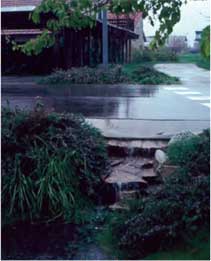Low Impact Development (LID)
Local governments should be considering measures they can take now to make the most of the rain to come. The way we develop affects our ability to maintain sufficient water supply and quality.

Low impact development can reduce runoff volume by infiltrating rainfall into the ground where it can be taken up by plant roots or enter groundwater systems. LID is economical, costing less than conventional stormwater management systems to install and maintain, in part, because of fewer pipe and belowground infrastructure requirements.
Local governments should also incorporate water holding areas – such as creek beds, recessed athletic fields, ponds and cisterns – into the urban landscape to recharge groundwater, reduce runoff, improve water quality, and decrease flooding (The Ahwahnee Water Principles: A Blueprint for Regional Sustainability).
Los Angeles has created a number of low impact development models using bonds and reallocating funding from hard infrastructure projects to provide finance green infrastructure projects that achieve water conservation, water quality, flood protection and stormwater management objectives.
In the late 1990s, the LA County Department of Public Works diverted funds from a proposed $42-million storm drain and allocated the money instead to retrofitting the watershed in accordance with the principles of sustainable watershed management.
In 2004, Los Angeles voters overwhelmingly passed Proposition O, which authorized the City to issue $500 million in general obligation bonds for water conservation, water quality, flood protection and stormwater management projects.
They also passed a LID ordinance in 2012 to ensure that development and redevelopment projects mitigate runoff using natural resources and capturing rainwater at its source.
The Los Angeles County Department of Public Works, the City of Los Angeles, a local nonprofit (TreePeople) and other stakeholders partnered to create a large-scale, sustainable watershed management demonstration project in the Sun Valley Watershed in the San Fernando Valley. The project integrates flood control, stormwater pollution reduction and water conservation efforts through infiltration and stormwater recycling practices.
By taking a sustainable approach, they were able to achieve additional benefits, including improving recreational resources and wildlife habitat and enhancing aesthetic amenities in the watershed. Projects include large-scale infiltration basins such as the Sun Valley Park Project, constructed wetlands, tree plantings, development of parks and open space, and storm drains systems designed to convey stormwater to the project areas.
To learn more, attend the March 2014 Ahwahnee Conference to hear about the project firsthand from TreePeople’s Andy Lipkis.
Local Government Commission Newsletters
Livable Places Update
CURRENTS Newsletter
CivicSpark™ Newsletter
LGC Newsletters
Keep up to date with LGC’s newsletters!
Livable Places Update – April
April’s article: Microtransit: Right-Sizing Transportation to Improve Community Mobility
Currents: Spring 2019
Currents provides readers with current information on energy issues affecting local governments in California.
CivicSpark Newsletter – March
This monthly CivicSpark newsletter features updates on CivicSpark projects and highlights.



